Are you looking for a way to personalize your body art and create your own custom designs? If so, then learning how to use tattoo paper is the perfect solution for you! Tattoo paper is a great way to transfer your designs onto your skin with ease. This step-by-step guide will show you how to use tattoo paper to create your own unique designs.
Contents
What Is Tattoo Paper?
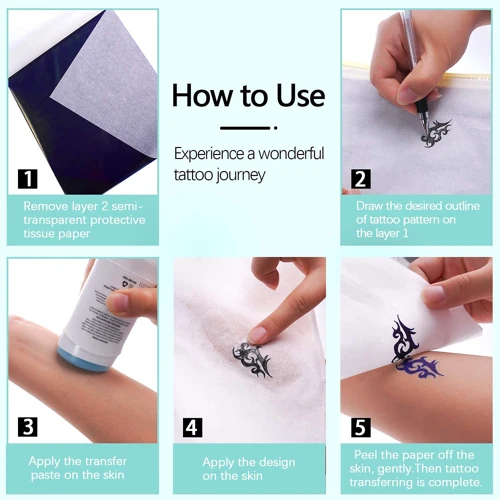
Tattoo paper is a special tattoo transfer paper designed to help you easily create your own custom designs. It is a special type of paper that is coated with a layer of color-reactive dye, which, when heated, transfers the design onto the skin. This layer of dye is typically made up of a combination of pigments, waxes, and other materials that allow it to adhere to the skin without fading or smearing. The paper is available in a variety of colors and sizes, allowing you to create unique and personalized tattoos. Tattoo paper is a great way to experiment with body art without committing to a permanent design.
Using tattoo paper is a relatively simple process. First, you will need to design your tattoo. You can use a variety of software programs, or draw your design by hand. Once you have finalized your design, you will need to print it onto the tattoo paper. Once printed, you will need to cut out the design and place it onto the skin. Finally, you will need to use a heat source, such as an iron, to transfer your design onto the skin.
Using tattoo paper is a great way to experiment with body art without the commitment of a permanent tattoo. With a few simple steps, you can easily create your own custom designs.
What You Need for Applying Temporary Tattoos
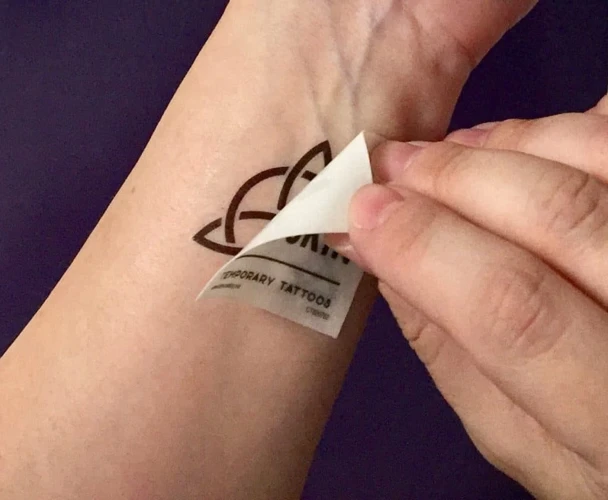
Tattoo Paper: Make sure to buy the right kind of tattoo paper for your printer. There are two types of tattoo paper: wax-based and water-based. Wax-based tattoo paper works with inkjet printers and water-based tattoo paper works with laser printers.
Inkjet Printer: To print with wax-based tattoo paper you will need an inkjet printer.
Laser Printer: To print with water-based tattoo paper you will need a laser printer.
Tattoo Transfer Solution: Tattoo transfer solution is a liquid specifically designed to transfer the printed design onto the skin.
Scissors: After you have printed your design, you will need a pair of scissors to cut it out.
Sponge: You will need a sponge and warm water to moisten the tattoo paper and activate the transfer solution.
Towel: You will need a towel to dry the skin after applying the tattoo paper.
Preparing the Skin for Applying Tattoos
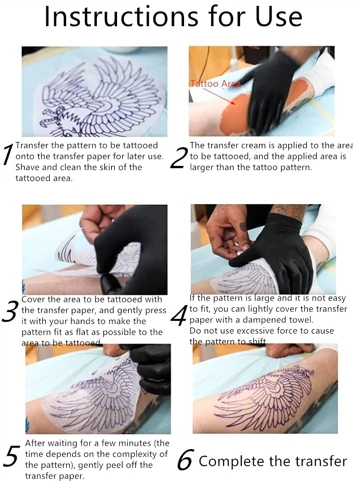
Cleanse the skin:
- Wash the skin with a mild soap and warm water.
- Dry the skin with a clean towel.
Exfoliate the skin:
- Gently scrub the area to be tattooed with an exfoliating scrub.
- Rinse the skin with cold water.
- Dry the skin with a clean towel.
Apply a thin layer of petroleum jelly:
- Apply a thin layer of petroleum jelly to the area to be tattooed.
- Allow the petroleum jelly to dry completely.
Shave the area:
- Shave the area to be tattooed with a clean razor.
- Rinse the area with cold water.
- Dry the area with a clean towel.
Apply a thin layer of alcohol:
- Put a few drops of rubbing alcohol on a clean cotton ball.
- Gently dab the area to be tattooed with the cotton ball.
Steps for Applying Temporary Tattoos
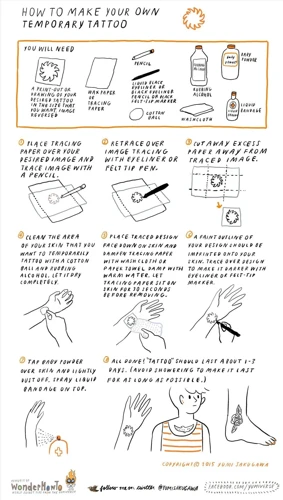
Print Your Design
Using tattoo paper, print the design of your choice on the designated side of the paper. Make sure your tattoo does not exceed the size of the paper, as this will affect the quality of the tattoo.
Cut Out Design
Once the design is printed, use scissors to cut out the tattoo. Carefully cut along the outline of the design so that all of the details are visible.
Peel off Backing
Once the tattoo is cut out, carefully peel off the backing of the tattoo paper. Make sure not to pull too hard and damage the design.
Apply to Skin
Press the tattoo firmly to the skin. Make sure to press out any air bubbles and to smooth out the design.
Press Firmly
Using a paper towel or cloth, press firmly on the tattoo for 10 seconds to ensure that it is applied properly.
Wet with Sponge
Dampen a sponge with water and lightly rub it over the tattoo. This will help to activate the adhesive on the tattoo.
Peel off Front Sheet
Carefully peel off the front sheet of the tattoo. The tattoo should now be visible on the skin.
Tips for Applying Temporary Tattoos
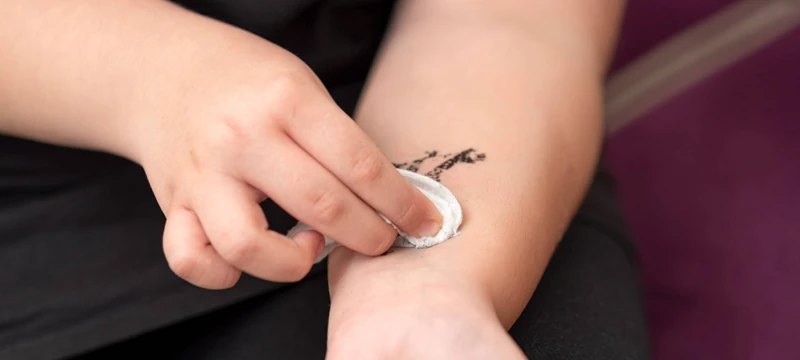
- Clean the area that you plan to apply the tattoo to. Before applying the decal, make sure that the area is clean and dry. This will ensure that the tattoo sticks better and won’t be easily removed.
- Cut out the tattoo. Use a pair of scissors or a craft knife to carefully cut out the tattoo image. Make sure that you don’t leave any jagged edges.
- Remove the clear sheet. Peel off the clear sheet that covers the tattoo.
- Apply the tattoo. Place the tattoo face down on your skin and press down firmly. Hold it in place for a few seconds.
- Dab off excess water. After pressing the tattoo onto your skin, dab off any excess water with a paper towel.
- Wait for it to dry. Allow the tattoo to dry for a few minutes before you touch it or get it wet.
Caring for Temporary Tattoos
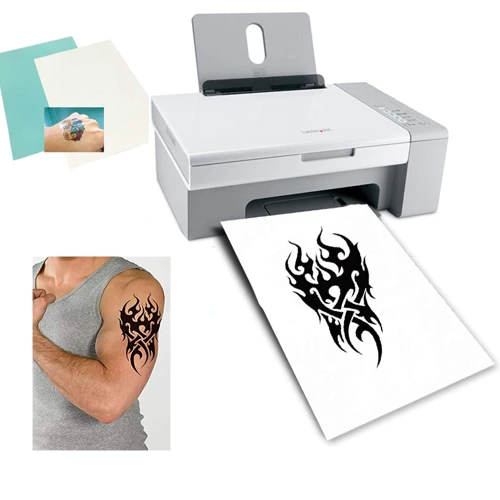
Cleaning – It’s important to keep your temporary tattoo clean to ensure it lasts longer. Gently clean the area around the tattoo with soap and lukewarm water. Avoid scrubbing the tattoo as this can cause the ink to fade sooner.
Moisturizing – To keep your temporary tattoo looking its best, use a mild lotion or moisturizer to keep the area hydrated. This will help your tattoo to last longer and also keep it looking vibrant.
Protecting – Protect your temporary tattoo from direct sunlight, chlorine, and other elements that can cause fading. If you plan to swim or spend a lot of time in the sun, consider covering your tattoo with a band-aid or wrap the area with a cloth.
Removal – When you’re ready to remove your temporary tattoo, use rubbing alcohol or baby oil to help loosen the ink. Gently rub the area until the ink is removed. If any ink remains, repeat the process until the tattoo is fully gone.
Storage – To make sure your tattoo paper lasts longer, store it in a sealed bag or container. This will help to protect it from dust, dirt, and other elements that can cause damage.
Table
| Step | Instructions |
|---|---|
| Cleaning | Gently clean the area around the tattoo with soap and lukewarm water. |
| Moisturizing | Use a mild lotion or moisturizer to keep the area hydrated. |
| Protecting | Protect your temporary tattoo from direct sunlight, chlorine, and other elements. |
| Removal | Use rubbing alcohol or baby oil to help loosen the ink. |
| Storage | Store it in a sealed bag or container. |
Removing Temporary Tattoos
- Lotions and Soaps: Lotion or soap can be used to remove temporary tattoos. Rub the lotion or soap onto the tattoo and then rinse off with water. Repeat this process until the tattoo is completely removed.
- Rubbing Alcohol: Rubbing alcohol can also be used to remove temporary tattoos. Put some rubbing alcohol onto a cotton ball and rub it onto the tattoo. Keep rubbing until the tattoo is gone.
- Baby Oil: Baby oil is another great way to remove temporary tattoos. Rub some baby oil onto the tattoo and then rinse off with water. Repeat this process until the tattoo is gone.
- Lemon Juice: Lemon juice is another great way to remove temporary tattoos. Put some lemon juice onto a cotton ball and rub it onto the tattoo. Keep rubbing until the tattoo is gone.
- Exfoliating Scrub: An exfoliating scrub can also be used to remove temporary tattoos. Rub the exfoliating scrub onto the tattoo and then rinse off with water. Repeat this process until the tattoo is gone.
Frequently Asked Questions
What Kind of Printer and Ink Do I Need to Use Tattoo Paper?
For optimal results, it is recommended to use an inkjet printer with permanent pigment-based inks. This type of inkjet printer will ensure that the tattoo paper prints crisp and clear, and will keep the design durable and long-lasting. Avoid using dye-based inks, as these are not designed for tattoo paper and can cause fading.
Is it Safe to Use Tattoo Paper?
- Tattoo paper is generally safe to use, as it is designed to be used on the skin.
- The paper is made from non-toxic materials and is safe for use on the skin.
- The adhesive on the paper is also non-toxic and will not cause any irritation.
- Tattoo paper is not recommended for those with sensitive skin, however, as the adhesive may cause an allergic reaction.
- If you are unsure whether or not the paper is safe for use on your skin, it is recommended that you consult your doctor before attempting to use it.
How Long Do Custom Tattoos Last?
Custom tattoos typically last between one and two weeks with proper care. To extend the life of your tattoo, keep the area clean and moisturized with lotion, and avoid scratching or rubbing the design. Additionally, avoid direct exposure to the sun and swimming for the first few days to ensure your tattoo looks its best for as long as possible.
What Design Software Can I Use to Create a Design for My Tattoo Paper?
Adobe Photoshop or Illustrator are great software programs for creating complex, multi-layered designs for tattoo paper. They both offer a range of features such as vector drawing, layer masks, and text tools. Inkscape is another free vector drawing program that can be used to create simple designs for tattoo paper. For more basic designs, Microsoft Paint or a basic drawing program can be used too.
Is there a difference between temporary and permanent tattoo paper?
Temporary tattoo paper allows the user to create their own custom temporary tattoos that can be easily removed, while permanent tattoo paper is used to create a lasting tattoo. Temporary tattoos are created using a special transfer paper, while permanent tattoos are done using special tattoo machines or needles. Temporary tattoos can be created at home, while permanent tattoos should be done by a professional tattoo artist.
Conclusion
Tattoo paper is an easy and inexpensive way to make your own custom designs. With a few simple steps, you can create a unique and personal design that can be applied to your body. With this guide, you can get started creating your own custom tattoo designs with ease.